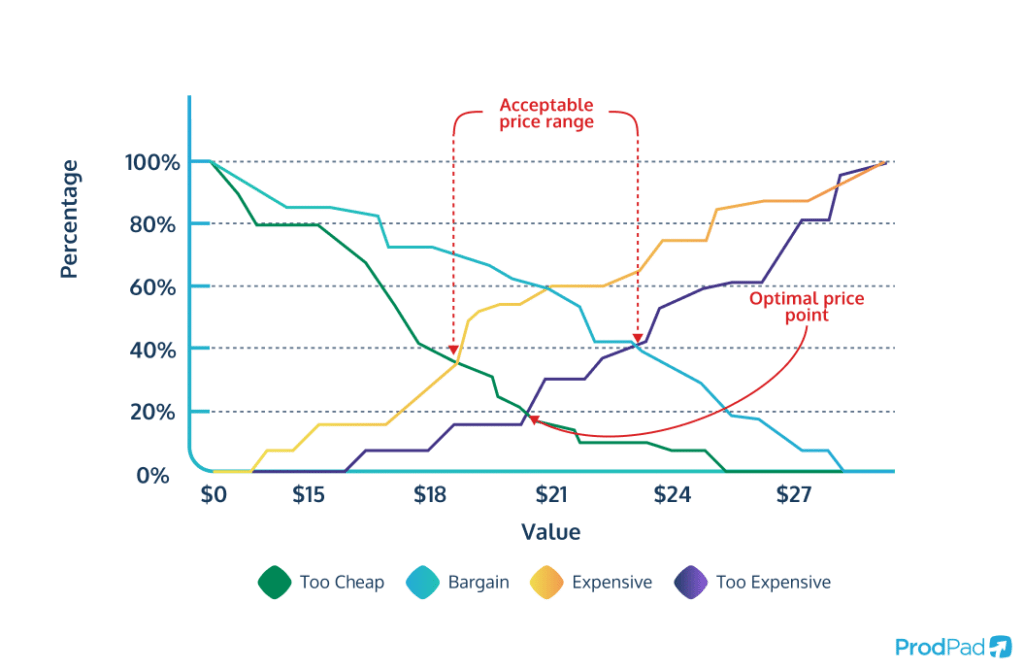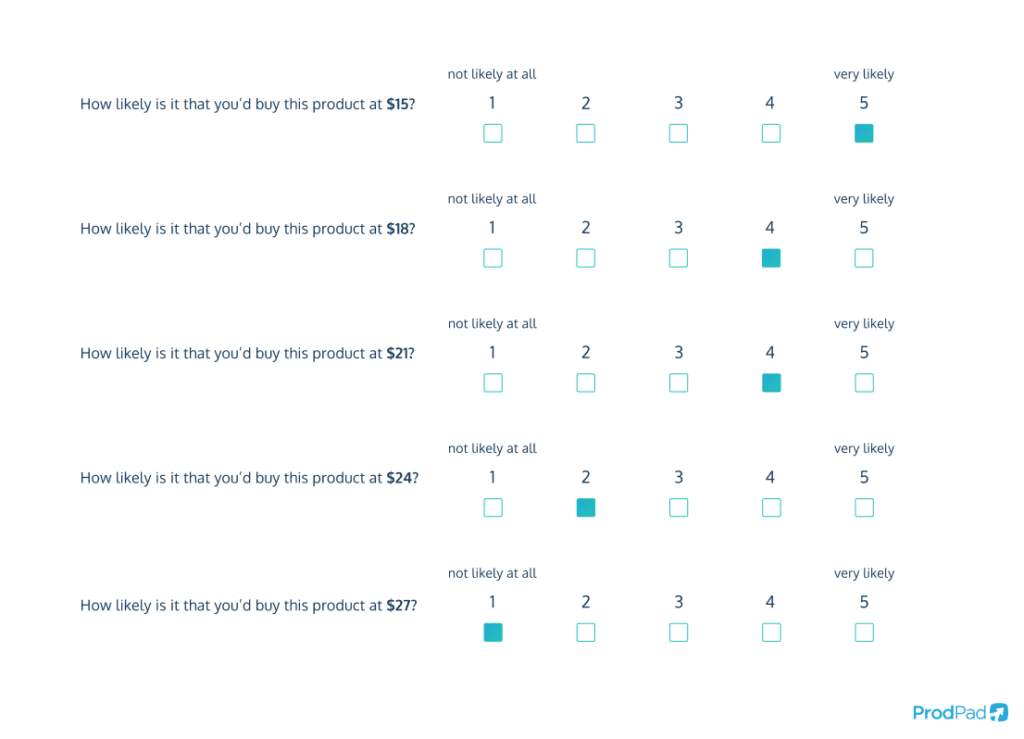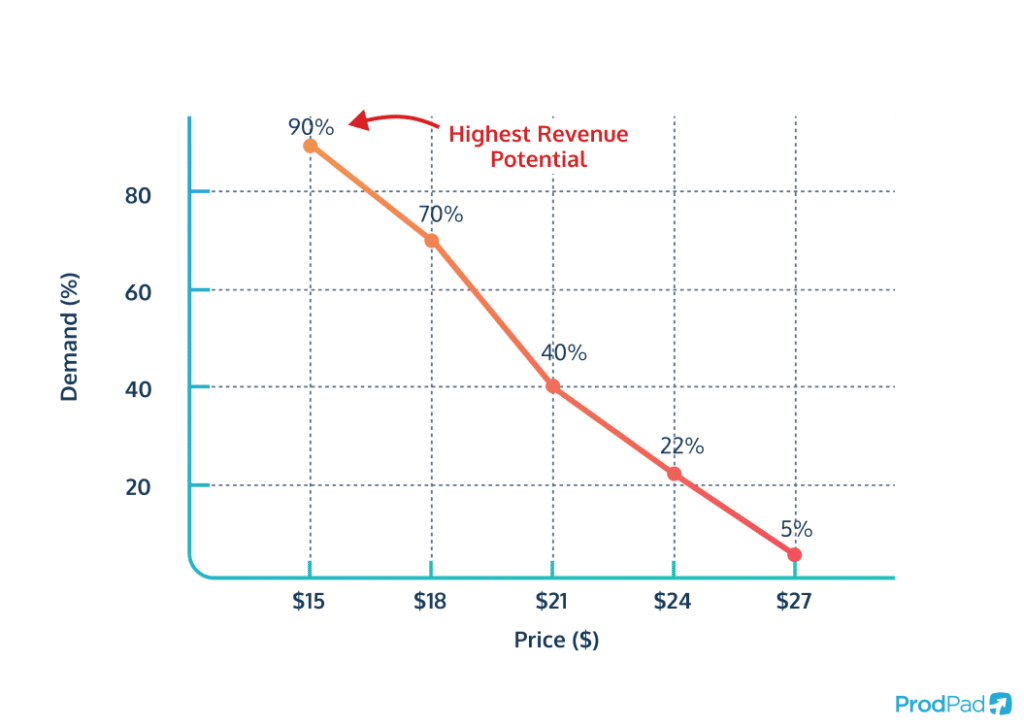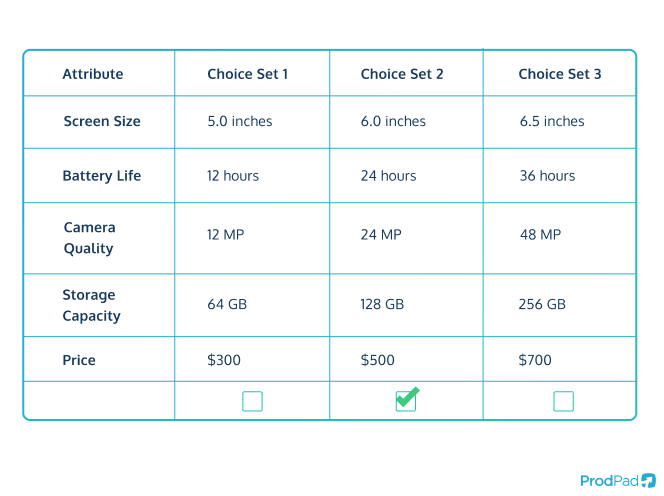Product Price Testing: How to Know When the Price is Right
Are you charging the right price for your product? Are you super-duper sure that you’ve gotten your price strategy right? If you have even a sliver of doubt, then it might be worth doing some product price testing.
Look, it’s hard to land on the perfect price point for your product. It’s often said that you rarely get your pricing right, it’s a case of trying to get it less wrong. Because nearly all markets and customer needs are in constant flux – what worked one year, might not land well the next. But your pricing is one of the fundamental levers you have at your disposal to make a significant impact on your revenue and profit. So it’s worth taking the time to test.
A lot of businesses can be reluctant to play around with their pricing. Many product and commercial leaders can suffer from a ‘set and forget’ mindset when it comes to product pricing. That can quickly lead to prices being outdated and poorly reflect your value proposition, your growth or the market.
It’s said that an average business alters its pricing only once every three years. This is leaving money on the table! Many pricing experts, like Patrick Campbell, suggest you should look to change your pricing once every three months! 😱
Sometimes you might find that your entire product pricing strategy or pricing model is flawed. Sometimes the overall strategy is solid, but the actual price points might need adjusting. The results of product price testing can be varied, but it’s important to make a start and see what the findings are. Let’s get the test tubes and beakers out and do some product price testing to help you discover the approach to pricing that works for you.
Haven’t got a clue what a product pricing strategy is? We’ve got an in-depth article about your main options and how to successfully change between them. It’s worth reading so you’ve got baseline knowledge of what we’re talking about here.
Why should you run product price testing?
Imagine you’re baking a cake. You wouldn’t just throw it into the oven without checking it and measuring its progress with a timer. The same goes for your pricing. Product price testing ensures that your pricing is right – stopping you from scaring customers away with a large price tag that makes them nervously look for the ‘cancel subscription’ button.
Conducting product price testing helps you be confident that you’re pitching your product at a price point that accurately reflects its market perception and value proposition. How much your product is worth will change as it and your product grows, so you need to monitor this and stay aware of any big changes.
Let’s illustrate this with a story:
Say we start a new side business – go us✨ – and release a new product. Let’s say a video streaming service called ProdTV, where users can watch our great catalog of webinars (which you can check out below) alongside other blockbusters.
Browse our on-demand webinars.
Now as ProdTV is new, and because there are already a few industry giants knocking around showing the latest movies and must-see TV, ProdTV decides to follow a competitor-based product pricing strategy and undercut the market, charging less than these big players.
Now let’s say over a few years, people grow to love ProdTV. It’s got an equal viewership to the competitors and has managed to bag some exclusive, high-rated content that everyone is loving. Shows that are so good that people are willing to pay way more than the original budget-friendly price to watch. Do you think sticking with that budget price point is still right?
Of course not. Now it’s time to change the pricing, and perhaps follow a value-based product pricing strategy that positions ProdTV as a premium option. Product price testing allows you to not only see when it’s right to switch things up, but it can also help you determine what the best prices are.
Because if we go back to that example, and decide to increase the costs to where it’s way more than other streaming services, ProdTV may start to alienate existing customers and lose viewership quickly. Without effective product price testing, ProdTV could get the change wrong, piss all their viewers off, dramatically lose revenue, have their exclusive shows canceled, and die a horrible death.
Now, don’t worry, we won’t be launching ProdTV any time soon, but if we were, we’d be using product price testing to make sure that we find that pricing sweet spot. A full list of reasons to test your product pricing includes:
- You avoid guesswork: Testing helps you make data-driven pricing decisions rather than relying on assumptions.
- You can maximize profit potential: product price testing allows you to find the sweet spot where your price meets customer willingness to pay, optimizing your margins.
- You adapt to market changes: Regular testing ensures your pricing remains competitive as market conditions and customer preferences shift.
- You have better customer insights: Pricing tests reveal how much value customers place on your product and what drives their buying decisions.
How often should you run product price testing?
If we go back to the wise words of Patrick Campbell, product pricing guru, then we need to be changing or augmenting our pricing every three months or so. This means that we should be testing our prices this often too.
Now we get it, many Product Managers can feel a tad uncomfortable making or recommending changes to their pricing this frequently. If you’re not used to it, it can feel daunting. Now our first bit of advice is to suck it up, put on a brave face, and test and experiment regularly, but if that’s not you, here’s the lowdown of the minimum testing frequency you should hit.
If you’re a fast-moving startup or in a super-dynamic market, you still might want to price test every few months. This lets you keep pace with competitors and adapt to customer trends quickly. On the other hand, if your product is more established or in a slower-changing industry, a yearly or biannual review should be enough to keep things fresh without causing chaos.
Alternatively, you could also follow the trigger approach to help you determine when you should run product price testing. This approach is all about reacting to various big changes, such as a new competitor entering the market, shifting demand, a big change in AARRR (Pirate Metrics) or customer churn, or if you release a large product update. Basically, if something big happens, it’s a good time to test.
Of course, you don’t want to overdo it with your product price testing and do it too regularly, as that’s going to burn you out and, if you’re making constant tweaks, that could potentially irritate your customers. It’s a bit like exercising, you want to do it frequently enough to stay fit, but not so much that you hurt yourself. Keep a regular schedule, but always be ready to react when the market shifts.
What are the different product price testing methods?
There are quite a few different ways to price test. We recommend using any of these price testing methods to get a nice broad range of results. As you’ll soon see, many of these testing methods are customer-centric, leveraging customer feedback to allow you to get direct insight from your users to help determine the best price possible.
Testing demand elasticity
Before checking out the various price testing methods, we need to talk about demand elasticity. This term describes how much your customer demand changes when a product price changes. It can tell you a lot about how important your price is when it comes to feature adoption and user retention. Here’s how to work it out:

So if you increase your price by 20% and lose 8% of your customer base, your elasticity of demand will be -0.4.
This is actually pretty good, as any score between 0 and -1 shows that you have inelastic demand – customers are less sensitive to price changes. If you get a score below -1, it demonstrates that you have elastic demand, meaning that your customers are super sensitive to price changes.
If you get a score of -1 exactly, it means that you have unitary elastic demand. This shows that the change in demand and price is proportional. If you change the price by 10%, your demand will also change by 10% the other way.
Having a good grasp of your demand elasticity can help you decide which price testing method is best and if you’re in a good position to change pricing.
Van Westerndorp price testing
If you’re keen to check if your product pricing is hitting the mark, you can use Van Westerndorp analysis to figure out your ideal price point, based on customer feedback.
In this type of analysis, you ask customers four simple questions to help you get an idea of the value of your product and how your customers perceive your pricing.
To get started, you first need to pick the customers you want to ask. You can do this as a general survey, or make use of your Customer Advisory Board to get results from a core group of users you trust. When you’ve chosen your customers, ask them the following four questions:
Q1. At what price would you consider the product/service to be priced so low that you feel that the quality can’t be very good? (Too Cheap)
This question helps you see what price point would be too cheap in the eyes of your customers. Although everyone loves a bargain, there is a lower limit where users may start to question the value of your product. It’s like buying a burger for 25¢, would you trust it to not make you sick?
Q2: At what price would you consider this product/service to be a bargain – a great buy for the money? (Bargain)
This question allows you to establish the lowest price that users would pay for your product, and at what price point they’d be the happiest to pay. This price allows you to get a minimum idea of what your customers think you should be charging for your product.
Q3: At what price would you say this product/service is starting to get expensive – it’s not out of the question, but you’d have to give some thought to buy it? (Expensive)
This question lets you know at what price point customers will start to struggle to justify paying for your product. At this price, if you’re able to show the value of your product and create a wow moment when users are testing it out, you may still be able to convert the customer. This price usually indicates the most expensive price you can charge before the majority of your customers start to seriously question the price.
Q4: At what price would you consider the product/service to be so expensive that you would not consider buying it? (Too Expensive)
This final question lets you work out what price would be too expensive and indicates a price point that you should avoid for fear of putting your customers off.
With these four questions asked, you can then plot your answers on a Price Map. Here, the x-axis represents the range of answered prices and the y-axis is the percentage of customers who answered for each price. This then creates a line chart for each question, allowing you to spot areas where they intersect and overlap. These areas of intersection illuminate things like the optimal price point. The sweet spot.
This optimal price point is represented where the line charts of Too Cheap and Too Expensive intersect. This helps you see what your prices should be in the eyes of your customers. If they align with your costs and other factors, then it may be a good idea to alter prices to this sweet spot.

Gabor Granger price testing
This product price testing model is pretty similar to the Van Westerndorp approach. In both, you’re asking direct questions to your customers about your price, creating surveys that allow you to dive deeper into the percentages to find a good price range.
In the Gabor Granger (no it’s not a Harry Potter character) method, you ask a series of questions about your product, asking customers how likely they are to buy your product at various prices. Your surveys will look like this:

The purpose of this test is to see if you can raise the price of your product without hurting your sales too much. You’ll plot your results on a graph, with your tested prices on the x-axis and the demand percentage on the y-axis.
This graph is going to have a line that curves downwards as your proposed prices become less and less attractive. When reading the graph, you want to analyze the steepness of the curve, as a flat drop suggests that your customers have inelastic price sensitivity. You also want to find the price where you have the highest revenue potential. This is done by multiplying each price by the percentage of customers that would pay it.

Conjoint price testing
This product price testing method is a bit more subtle than the previous two, as instead of just asking about price as the major deciding factor, you’re also including other attributes of your product that users will assess to see if it’s worth it.
Here you combine different product characteristics – with pricing being one of them – to present a selection of complete products that your customers will then choose from. For example, say you sell smartphones. In your conjoint price testing, you’ll create multiple different options with varying attributes. This can be a great way to get really useful feedback.

When getting customers to vote on their favorite, it’s best to do a few rounds of different options. It’s best practice to have around 10 to 15 different screens like above, all with varied choice sets that are arbitrarily put together to get as much information as possible.
From this data, you’ll want to work out the utility scores and preference scores. These tell you how important each attribute was to the pricing. This isn’t something you can do with good old-fashioned brain power. You’re going to have to utilize conjoint software to pull out the data for you.
Once analyzed, you’ll be able to see the utility scores for all the price points you mentioned. With this, you can then choose the price with the highest as your benchmark, knowing that this is what your customers consider the optimal price. That said, it’s also worth checking out what other factors had a high utility score, as this can influence how you design and create your product in the future.
Of course, you need to make sure that the best price utility score is balanced with your cost structure and profit margins.
Common product price testing mistakes
Don’t fall into the trap of getting product price testing wrong. Many things can go array, which can then spoil your results and give you an unreliable price point that doesn’t work. Keep your eye on some of these potential issues to make sure that you get price strategy testing right.
- Using a small sample size: Testing with too small a group can give you unreliable results that don’t represent your actual customer base. You need enough data to back up your decisions and avoid misleading conclusions.
- Testing too many variables at once: If you tweak too many elements (like price, features, and promotions) all at once, it’s hard to know what’s really affecting customer behavior. Stick to isolated changes to get clearer insights.
- Overlooking long-term data: Focusing only on the immediate sales data after a price change can lead to misguided decisions. You need to look at long-term trends to understand the real impact on customer lifetime value and brand loyalty.
- Ignoring competitive factors: Failing to account for competitor pricing and market trends can leave your testing out of sync. You don’t operate in a vacuum – what your competitors are doing should shape your testing strategy.
A (bad) word on A/B price testing
You may have spotted that we didn’t include A/B testing as a potential method. This is a pretty big omission as you’ll find it on many other lists going through the common testing methods.
Now A/B testing is great in multiple contexts. It can help you pinpoint the right version of your product, determine the perfect customer demographics you should target, and way more. We love A/B testing, putting two ideas against each other is a great way to figure out what’s best. That all said, it’s not great for product price testing.
The main issue is that if you do A/B price testing wrong, it can be very unfair. If you’re testing two different prices, you’re going to end up with some customers paying more than others for the exact same thing. If word got out about that (and you can bet it will), you can imagine how that’s going to hurt your brand reputation. It can also dissuade potential buyers from purchasing.
And another thing, think about what happens once you choose the price you want to charge out of the two A/B options. What happens to the others? They’re still going to be paying an outdated price, which causes headaches. Do you just leave them paying the wrong price? Do you try and get them to change? It’s tricky, and it’s best to be avoided.
And another, another thing, it can be really hard to get enough data from A/B testing to be worthwhile. You need to get a lot of people involved in your A/B testing to get results with statistical significance. If you don’t get enough people purchasing your product with your A/B prices, it’s just going to be pure chance, which can skew your results.
And another, another, ANOTHER thing, getting an A/B test up and running takes a lot of time and resources. This can be a pretty large and likely meritless effort.
Phew 😤. Feels good getting that off our chest. In short, we think A/B price testing can do more harm than good, especially if it’s done clumsily. The other pricing strategy testing methods provide great insight and should eliminate your need to do A/B testing.
To the lab!
Testing your product pricing is a worthwhile endeavor, something that you should be doing regularly. Get your best lab coat on, put on your safety goggles, and get ready to geek out over some data. Testing will help you confidently find the optimal price point for you, taking away any guesswork and replacing it with hard evidence.
By measuring how customer interest shifts with price changes, you can see whether your product has wiggle room for price increases – or if even small bumps will scare customers away.
Remember, pricing isn’t static – markets shift, customer preferences evolve, and what worked for you yesterday might not hit the mark tomorrow. You’ve got to be open to change; an outdated pricing strategy could hold you back.
But that’s not the only outdated thing that can hold you back as a Product Manager. If you’re using traditional time-based roadmaps 🤮 or generic task management software, you may be struggling to keep up with the times. It could be time to revamp and move on to a future-proof option like ProdPad. Our solution is constantly innovating to keep up with customer needs and market trends. Come have a look at ProdPad yourself and see how it can make you a better Product Manager.
Learn more about ProdPad firsthand.